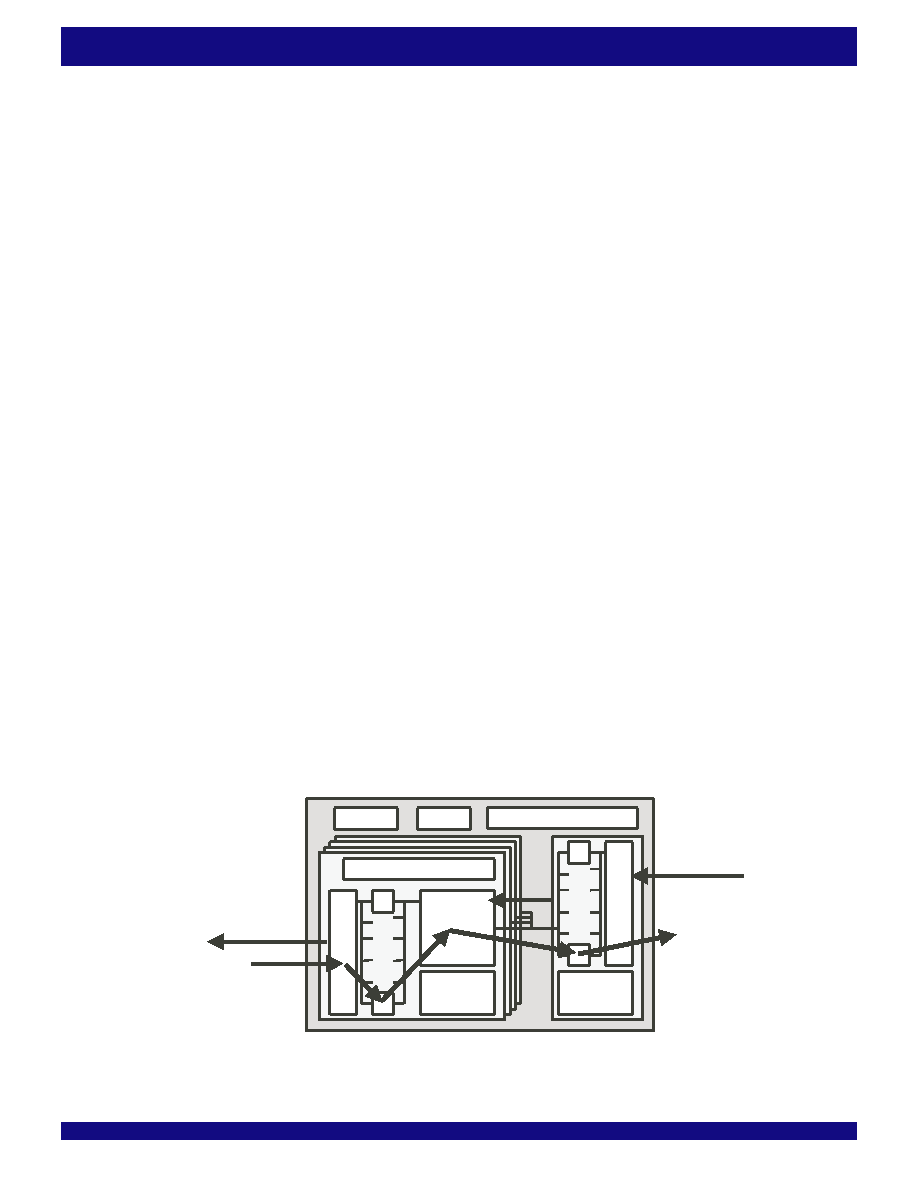- 您現(xiàn)在的位置:買賣IC網(wǎng) > PDF目錄1924 > IDT88P8342BHI (IDT, Integrated Device Technology Inc)IC SPI3-SPI4 EXCHANGE 820-PBGA PDF資料下載
參數(shù)資料
| 型號: | IDT88P8342BHI |
| 廠商: | IDT, Integrated Device Technology Inc |
| 文件頁數(shù): | 22/98頁 |
| 文件大小: | 0K |
| 描述: | IC SPI3-SPI4 EXCHANGE 820-PBGA |
| 標(biāo)準(zhǔn)包裝: | 24 |
| 系列: | * |
| 其它名稱: | 88P8342BHI |
第1頁第2頁第3頁第4頁第5頁第6頁第7頁第8頁第9頁第10頁第11頁第12頁第13頁第14頁第15頁第16頁第17頁第18頁第19頁第20頁第21頁當(dāng)前第22頁第23頁第24頁第25頁第26頁第27頁第28頁第29頁第30頁第31頁第32頁第33頁第34頁第35頁第36頁第37頁第38頁第39頁第40頁第41頁第42頁第43頁第44頁第45頁第46頁第47頁第48頁第49頁第50頁第51頁第52頁第53頁第54頁第55頁第56頁第57頁第58頁第59頁第60頁第61頁第62頁第63頁第64頁第65頁第66頁第67頁第68頁第69頁第70頁第71頁第72頁第73頁第74頁第75頁第76頁第77頁第78頁第79頁第80頁第81頁第82頁第83頁第84頁第85頁第86頁第87頁第88頁第89頁第90頁第91頁第92頁第93頁第94頁第95頁第96頁第97頁第98頁

29
IDT88P8342 SPI EXCHANGE 2 x SPI-3 TO SPI-4
INDUSTRIALTEMPERATURERANGE
APRIL 10, 2006
SPI-3 ingress to SPI-4 egress flow control
For control information there are two separate cases to consider: The case
that the SPI-3 physical interface port is configured in Link mode, and the case
that the SPI-3 is configured in PHY mode. Note that since the SPI-3 physical
interfacesareconfiguredseparately,thedeviceisabletodealwiththecasethat
some of the LP fragments have been received on a Link layer device SPI-3
interfaceandsomehavebeenreceivedonaPHYlayerdeviceSPI-3interface.
For a device in Link mode the Link device can only control the flow of data
through the RENB signal. Two modes of operation are implemented and
configurable for flow control on this interface – either the data can be allowed
to flow freely into the device or the RENB signal will be asserted if a condition
arisesthatoneoftheLPsisunabletoreceiveanotherfragment.Thefirstofthese
modes is considered to have no Link layer device flow control, and the second
has Link layer device flow control.
For the no Link flow control mode, any data sent to an LP unable to receive
another fragment will cause an LP overflow.
For a device in Link mode the Link has complete knowledge of the fill level
ofthedatabuffersineachoftheLPsinthePHY.Thisknowledgeisattainedeither
through byte level polling or packet level polling.
Both in Link and PHY modes, the data is collected to buffer segments
associated with an LP. The SPI-4 PFP is updated with the number of free
segments available to the LP. The SPI-4 PFP determines which LP to service
based on two factors: whether the LP contains enough data for a burst, and the
starving / hungry / satisfied state of the LP. For details on the mapping of LPs
to LIDs, refer to Table 101 - SPI-4 egress LID to LP Map Block_base 0x0400
= Register_offset 0x00 - 0xFF.
SPI-3 ingress flow control registers
The following are implemented per SPI-3 interface, and there are two
instantiations per device.
Backpressure enable
Link mode only
Enables the assertion of the I_ENB pin when at least one active LID can not
acceptdata
Ifnotenabled,theI_ENBsignalwillneverbeassertedinLinkmode,possibly
leading to fragments being discarded.
SPI-4 egress flow control configurable parameters
All parameters as listed in SPI-4 implementation agreement:
CALENDAR_LEN: 4 to 1,024 in increments of 4
CALENDAR_M: 1 to 256 in increments of 1
MaxBurst1 (MaxBurst_S): 16 to 256 in increments of 16
MaxBurst2 (MaxBurst_H): 16 to 256 in increments of 16
Alpha: 1 to 256 in increments of 1
DATA_MAX_T: 1 to 4,294,967,040 in increments of 1
FIFO_MAX_T: 1 to 16,777,215 in increments of 1
SPI-4egressflowcontrolcalendarandshadowcalendar
256 entries
SPI-4 egress flow control multiple burst enable
Allows more than one burst to be sent to an LP. This feature was included
to increase throughput in systems with long latency between updates.
Figure 17. SPI-3 ingress to SPI-4 egress flow control path
ThediagrambelowshowstheSPI-3ingresstoSPI-4egressflowcontrolPath
through the IDT88P8342 device.
4
…
JTAG
uproc
LID Counters Memory
2 x SPI-3
8 bit / 32 bit
Min: 19.44MHz
Max: 133MHz
Interface
Bloc
k
Chip Counters Memory
Interface
Bloc
k
SPI-3 /
LID map
Main
Memory
A
SPI-4.2
Min: 80 MHz
Max:400 MHz
SPI-4 /
LID map
6371 drw12a
STATUS
DATA PATH
STATUS
相關(guān)PDF資料 |
PDF描述 |
|---|---|
| IDT88P8344BHI | IC SPI3-SPI4 EXCHANGE 820-PBGA |
| IDT89H24NT24G2ZBHLG | IC PCI SW 24LANE 24PORT 324BGA |
| IDT89HPES16NT2ZBBCG | IC PCI SW 16LANE 2PORT 484-CABGA |
| IDT89HPES24NT3ZBBXG | IC PCI SW 24LANE 3PORT 420-SBGA |
| IDT89HPES32T8ZHBXG | IC PCI SW 32LANE 8PORT 500-SBGA |
相關(guān)代理商/技術(shù)參數(shù) |
參數(shù)描述 |
|---|---|
| IDT88P8344 | 制造商:IDT 制造商全稱:Integrated Device Technology 功能描述:SPI EXCHANGE 4 x SPI-3 TO SPI-4 Issue 1.0 |
| IDT88P8344BHGI | 功能描述:IC SPI3-SPI4 EXCHANGE 820-PBGA RoHS:是 類別:集成電路 (IC) >> 專用 IC 系列:* 產(chǎn)品培訓(xùn)模塊:Lead (SnPb) Finish for COTS Obsolescence Mitigation Program 標(biāo)準(zhǔn)包裝:1 系列:- 類型:調(diào)幀器 應(yīng)用:數(shù)據(jù)傳輸 安裝類型:表面貼裝 封裝/外殼:400-BBGA 供應(yīng)商設(shè)備封裝:400-PBGA(27x27) 包裝:散裝 |
| IDT88P8344BHI | 功能描述:IC SPI3-SPI4 EXCHANGE 820-PBGA RoHS:否 類別:集成電路 (IC) >> 專用 IC 系列:* 產(chǎn)品培訓(xùn)模塊:Lead (SnPb) Finish for COTS Obsolescence Mitigation Program 標(biāo)準(zhǔn)包裝:1 系列:- 類型:調(diào)幀器 應(yīng)用:數(shù)據(jù)傳輸 安裝類型:表面貼裝 封裝/外殼:400-BBGA 供應(yīng)商設(shè)備封裝:400-PBGA(27x27) 包裝:散裝 |
| IDT89H10T4BG2ZBBC | 制造商:Integrated Device Technology Inc 功能描述:IC PCI SW 10LANE 4PORT 324BGA |
| IDT89H10T4BG2ZBBC8 | 制造商:Integrated Device Technology Inc 功能描述:IC PCI SW 10LANE 4PORT 324BGA |
發(fā)布緊急采購,3分鐘左右您將得到回復(fù)。